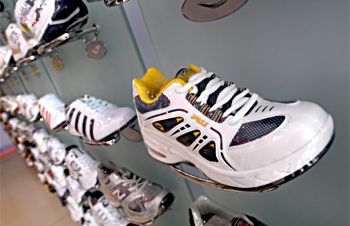This article was first published recently in www.sharesinv.com, and is reproduced here with permission. Ernest Lim, a professional investment manager, is a shareholder of China Sports and Sinotel Technologies.

THE RECENT fortnight saw companies such as Sinotel and China Sports (CSPORT) announcing share placementS. For Sinotel, it didn’t come as a surprise as it is well known that it has a long cash conversion cycle and requires funds for working capital purposes (refer to my article on Sinotel – Is Sinotel still an undervalued stock?).
However, it was a surprise for CSPORT (at least to me) as market talk was that there may be a privatization bid for CSPORT, fuelled in part by a DBS Vickers report which astutely pointed out that Epure, China Fishery and Pacific Andes had either applied for a dual listing, or were in preliminary discussion with another stock exchange.
I believed some investors are wondering why, with RMB869m of cash in CSPORT's books as of Sep 09, the company would still require the raising of approximately S$20.5m.
This comes on the back of the rights issue in Sep 09 where CSPORT raised S$16.1m. These actions cast doubts on whether the cash hoard exists, with the memory of Oriental Century still fresh in investors’ minds.
I made some enquiries with Parry Ng, VP Corporate Communications and Investor Relations, and summarised some of the findings here.
|
Q1: With RMB869m of cash in your books as of Sep 09, why would China Sports need to raise a small amount of RMB100m through a share placement? Why not use your internally generated funds?
CSPORT: Although the company is still in net cash position, the existing cash balance is reserved for other capital expenditure and expenses. These include:
a) Planning to construct a new plant to boost production capacity;
b) Planning to build a new multi-complex (including YELI showroom and FIFA showroom);
c) Setting up of approximately 100 new YELI specialty stores in FY2010 &
d) Catering for additional advertising and promotion (A&P) expenses for YELI products.
In an ideal scenario, it would be nice to be able to raise funds as and when the company needs it. However, after through the financial crisis, our CEO felt that it is more prudent to increase the cash buffer of the Group ahead of impending investments and capital expenditure (capex). Furthermore, banks are generally less supportive of small mid caps.
Q2. With regard to capital management, has management explored the idea of raising funds through debt (for e.g. via plain vanilla bonds), instead of share placement? If yes, can you explain the reason why you rejected debt issuance?
CSPORT: Getting bank loans from China is complex for small mid caps because Chinese banks usually give short term loans of one year, which is not practical for the company to use such short term financing to fund medium term projects.

Q3: Understand that China Sports is acquiring an industrial plot, pending government discussions since your announcement in 2Q09 results. What is the estimated amount of capital outlay? Do you have an indicative date / period when this can be finalised?
CSPORT: The Group is at an advanced stage of negotiation to acquire an industrial plot for the construction of a new manufacturing facility in Fujian Province. The estimated costs of acquiring the industrial plot and constructing the new plant are between RMB150 million to RMB180 million.
Upon completing acquisition of the industrial plot, the Group will commence construction of the new plant, which is estimated to take between 2 to 3 years from commencement of the works to completion.
Q4: Understand that China Sports has production facilities lines in JinJiang City. May I know what is your full production facility and utilisation rate as of now / Sep 09?
CSPORT: The Group has 8 production lines, with maximum capacity of about 17.6m pairs per annum. Company outsources between 25 to 30% of footwear volume.
Q5: When will the FIFA-related products start to contribute to China Sports top and bottom line?
CSPORT: FIFA project is a medium term project, which involves several phases:
Phase 1: Set up FIFA world cup event stores around April, ahead of 2010 world cup
Phase 2: Set up FIFA modular stores within YELI stores in 2H2010
Phase 3: Explore setting up of FIFA specialty stores
Since the rolling out is progressive, do not expect big earnings impact in 2010.
Q6: Does management continue to see cautious consumer sentiment and heightened competition in 2010?
CSPORT: In 3Q09 outlook statement, management mentioned that although PRC economy is gradually recovering, but we have experienced increased competition resulting in pressure on selling prices. We remain cautious about the operating environment in the near term.
Q7. What are the potential drivers for an improvement in the sports industry?
CSPORT: At the micro level, we see increased competition. We may have to wait till we see some consolidation for pricing power to return.
At the macro level: China has high personal savings rate, so once consumer confidence improves, they will start to spend more money.
|
So, what do I gather from the above abridged Q&A?
It is paramount to distinguish between short term (now to 3QFY10) and medium term horizon (4QFY10-FY11) where the growth rates for its top and bottom lines are different.
Short term horizon – Muted growth due to:
a) Aggressive expansion to crimp earnings growth:
For the short term, CSPORT is spending more on A&P, aggressive setting up of 100 speciality shops, establishment of the FIFA world cup event stores and FIFA Modular stores within YELI stores. All of these spending are likely to have an adverse immediate impact to its bottom line, whilst the positive contributions from the FIFA stores, as well as, the 100 speciality shops, are unlikely to offset the spending.

b) Inventory overhang pressures prices:
Furthermore, there is still some inventory overhang for footwear experienced in the market post Beijing Olympics. As a result, CSPORT has to reduce its average selling prices (ASP) so as to maintain competitive pricing for its distributors to capture more market share for its YELI products.
However, not all is doom and gloom even in the short term. This is because:
a) Strong China economic data to lend support to demand for CSPORT products:
Although, according to CSPORT 3QFY09 results, it states that it is seeing increasing competition and cautious consumer sentiment, China’s economic data such as purchasing manufacturing index and retail sales are generally strong. This should provide some support to demand for CSPORT products.
b) International sporting events to spur industry growth:
In addition, the Beijing Olympics in 2008 increased the Chinese consumers’ awareness on the benefits of sports and subsequently the need for sports products. Furthermore, the sporting industry is likely to be given a boost by several big international sports events, such as the FIFA World Cup in South Africa and the Asian Games in China’s Guangzhou city. According to Zhang Tao, vice-president of Anta Sports, the sports industry in China entered a fast development period post Beijing Olympics. He also added that his company is very confident about the sports industry in China.
Medium term – More pronounced growth as…
Investors should see more exciting growth in FY11 onwards based on three fronts:
a) Recovery of ASP
ASP for the footwear products should recover in the medium term due to reduction in inventory and potential industry consolidation.
b) Contribution from FIFA
The proposed establishment of FIFA world cup event stores and FIFA modular stores should start to have some meaningful contribution in FY11 and beyond. Besides, CSPORT product mix is likely to improve with FIFA products as they generally fetch higher selling prices (i.e. margins should be able to improve).
c) Domestic consumption to gain increasing importance
According to Credit Suisse Jan 2010 report, the most important macro theme over the next couple of years will be the closing of the gap between the US consumption share of GDP (71%) and China’s consumption share of GDP (36%). In addition, I expect that the 12th Five-year Plan (2011-2015) is likely to include more policies, which are conducive to domestic consumption, as China seeks to shift gradually from an export driven economy to a consumption-based economy.
Conclusion
With reference to the table above, China Sports, with its medium term growth drivers, is trading at a substantial discount to its peers. I believe China Sports should be able to trade to around 8.1x FY11 earnings (note its FY11 earnings) which should translate to a target price of S$0.285, or 58% upside from the close of S$0.18 on last Friday.
However, this stock is for investors who are willing to wait for China Sports to bear the fruits of its expansion plans, which are likely to materialise in 2011.







